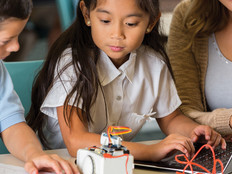How Digital Art Classes Are Blazing New Trails
Schools are finding new ways to take a digital approach to learning across K–12 subjects. That’s long been true in science, technology, engineering and math, which have been at the forefront of digital integration.
But as educational focus expands from just STEM to include arts in a STEAM approach, teachers are finding new applications for this kind of technology to encourage digital creativity in their classrooms.
That’s key in preparing students for the jobs that will be available to them when they graduate. In a recent study on creative problem-solving, Adobe found 86 percent of educators and 85 percent of policymakers believe students who excel at problem-solving will have better-paying jobs in the future.
Researchers encountered a discrepancy in the soft skills employers want, and the time and software it takes to build those skills. Authors of the study conclude that globally, 79 percent of educators say there’s a lack of time designated for creativity, and 73 percent say there’s a lack of access to software in classrooms.
MORE FROM EDTECH: Modern classrooms energize students and teachers.
Art Software Encourages Creative Digital Skills
One solution: Adobe Creative Cloud. The suite has more than 20 apps, including Photoshop, Illustrator and Lightroom, which give students an opportunity to flex their creative muscles while building skills using technology they’ll encounter in the workplace.
“Creative Cloud for K–12 provides a method for schools to deploy licenses to students of any age in a way that is consistent with the Children’s Online Privacy Protection Act (COPPA) and other data privacy laws,” writes Sharif Karmally, senior product marketing manager for Creative Cloud for Education, in an Adobe Blog post. “And, it can be set-up with a single sign-on so that students and teachers can use their existing school ID to access Creative Cloud.”
Educators see tools such as Adobe Creative Cloud and Spark for Education as ways to help students use the arts to build those needed problem-solving skills. “It’s very important in the 21st century for students to have the ability to be creative — not necessarily to be artsy, to have an arts background, but to be creative in approaches to a problem. How am I going to solve this? What are some of the ways that we can fix this?” said Claudio Zavala Jr., instructional technology coordinator at the Duncanville (Texas) Independent School District, at ISTE 2019.
For example, Zavala has seen students make digital collages using Spark for Education. The technology can be useful for teachers too, he added, for projects such as making videos, or creating open-house invitations and portfolios of their students’ work.
These apps also allow teachers to get a better view of students’ thought processes, and how their projects come together.
“They’ll write, they’ll do their research and then take their research and they’re able to talk about whatever they’ve learned and make their thinking processes visible to the teacher,” said Tanya Avrith, Adobe education evangelist, at ISTE 2019. “It really enables them to talk about where they were, what they got out of their learning journey, and where they ended up.”








